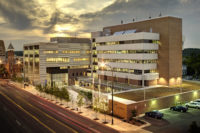Sustainable technologies help two schools reduce water and energy costs. Driven by rainwater harvesting (Manassas Park) and geothermal (Centennial) systems, these schools are enjoying impressive reductions in water and energy consumption - music to the respective school districts’ ears in today’s current economic climate.
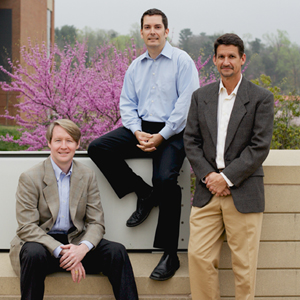
Manassas Park (Va.) Elementary School and Centennial High School in Burleson, Texas, are approximately 1,350 miles apart.
However, when it comes to embracing green technology, the two schools couldn’t be any closer in proximity. Driven by rainwater harvesting (Manassas Park) and geothermal (Centennial) systems, these schools are enjoying impressive reductions in water and energy consumption - music to the respective school districts’ ears in today’s current economic climate.
Rainwater to the rescue
At the forefront of Manassas Park Elementary School’s green practices is the use of a rainwater harvesting system. Rainwater falling onto the roofs of the prekindergarten and elementary school buildings is captured and flows through a dirt separator as well as additional filtering processes prior to going into a 79,000-gallon cistern. That water then pumps through additional filters and goes into both school buildings where it is used to flush toilets and urinals. The rainwater also irrigates athletic fields on the school grounds.
A domestic water well replaces water in the cistern in the event there is lack of rain for an extended period of time and the cistern level recedes below 18 in. If, in the unlikely event the well backup runs dry, the system switches over to municipal water.
The rainwater harvesting system features a SynchroFlo duplex nonpotable water booster pump package, a Norwesco treated water tank, Hayward duplex bag filters, Jay R. Smith floating filters, a Waterzone ozone system, Goulds transfer pumps, Xylem CentriPro control panels, Charlotte Pipe piping, Neptune meters and a BaySaver Technologies Hydrodynamic separator.
“Rainwater harvesting is pretty effective here,” says Steve Davis, LEED AP BD+C, director of sustainable design at Charlottesville, Va.-based VMDO Architects, the architects of record on the project. “In a place where you get 40 in. of rain and you have the right-sized tank, you can use it almost year-round.”
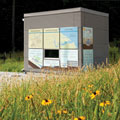
While the project team was expecting water savings from the rainwater harvesting system and the installed low-flow bathroom fixtures, it wasn’t quite prepared for what the data revealed.
“It’s more savings than we had projected when we were doing our original analysis,” Davis says. “Most of that has been because of the rainwater harvesting system. We thought it would take much longer for the system to pay off. But when you are saving $25,000 a year, in simple terms, it pays off quickly.”
VMDO Associate Wyck Knox, LEED AP, the project architect, admits typical model efficiency estimations can lean toward the aggressive side.
“Sometimes energy models can be liberal and you don’t quite get there,” he says. “We were expecting the same here and we got a nice surprise.”
Even more impressive is the comparison done on water consumption between Manassas Park Elementary School and the school building next door that does not have a rainwater harvesting system.
Davis notes in 2010 Manassas Park Elementary used 362,000 gallons of municipal water. With 840 students that year, that equates to 1.18 gallons per student, per day. The nonrainwater harvesting school next door averaged 7.56 gallons per student, per day.
“The K-2 building that does not have the rainwater harvesting system and was built 10 years earlier uses almost twice as much energy and 80% more water,” Davis points out.
2rw Consultants Principal Robert Crowell, P.E., LEED AP BD+C, explains the project’s projected annual water savings during design was 1.3 million gallons. The actual savings, he says, have been measured as 1.74 million gallons, approximately equal to the annual use of 19 four-person families. 2rw Consultants became the MEP engineering firm of record on the project.
“The school is in the middle of a neighborhood and we tried to relate the savings to what impact it might have on an individual home,” he says. “We’re also very fortunate to be able to compare the savings to the building next door and see the difference in the impact on the use of municipal water.”
According to school data, in a recent 12-month span dating from Feb. 1, 2011, to Feb. 1, 2012, the school realized $80,000 in combined water and energy savings.
“That’s real money,” Knox says. “That’s money to pay two teachers.”
In addition to the rainwater harvesting system, Manassas Park Elementary is equipped with Zurn low-flow faucets and lavs in the classrooms and restrooms, and Eemax instantaneous water heaters. The school kitchen has its own dedicated water heating unit, while bathrooms and science classrooms also contain their own units.
“We installed the individual water heaters so we were not installing pipe and recirculation pumps all over the place,” Crowell says. “We saved time and cost on installation, plus there is energy savings from the units.”
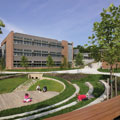
Taking green a step further
Water and energy savings are far from the only benefits the school is receiving from its sustainable technologies. The rainwater harvesting system also serves as a teaching tool for the students. VMDO is the driving force behind the school’s rainwater harvesting outdoor classroom.
“The cistern is essentially on the ground and the roof is at grade,” Davis says. “The school treats it as an outdoor classroom. The controls house is above grade and there is a window where you can look in and see what is going on. It’s a super-educational opportunity for the children to visibly see how water is saved and understand more of the connection between rain and water in the place they live a lot of their day-to-day lives.”
Another perk of the outdoor classroom is a special rain gauge. A 4-ft. by 4-ft. piece of Styrofoam with an aluminum pipe embedded in it floats in the cistern. That pipe comes up through a galvanized pipe sleeve and that sleeve is covered by a PVC sleeve. When the water level rises, the Styrofoam pushes up and the PVC cover opens, revealing the color-coded galvanized pipe. The color coding helps students see how much rain has fallen.
“The bus drops by there every day,” Knox says. “The kids will know if we’re in a drought condition or if we’ve had a lot of rain. It’s a fun way to show them how everything works.”
The teaching doesn’t begin and end with the rainwater system. Mechanical systems throughout the campus double as educational tools. “The way the school is using the whole rainwater collection system as a teaching tool is very innovative for a school system,” Crowell says. “The whole school is a learning environment for all the things around it. There are signs in the school teaching the kids about the local indigenous trees, foliage, birds and insects. They have a great curriculum there.”

Down in Texas, Centennial High School’s campus measures 550,000 sq. ft., making it a prime candidate for geothermal cooling and heating.
“When selecting your heating and cooling system, you take into consideration the layout, the size of the building and also the way the building is used,” explains Century Mechanical Contractors’ Chad Kroeker, P.E., the project manager on the job. “If you are designing an office building and expect the tenants to use it from 8 a.m. to 5 p.m., Monday through Friday, and then they lease the space out to a 24-hour health-care facility, the load for the building changes. Load changes are not good for geothermal well fields. Usually, a school building is used the same way year after year. Plus, it’s an economic way to spend taxpayer money. We’re seeing it used in a lot of school districts.”
Centennial High School has 1,748 wells (250 ft. deep each) spaced 15 ft. apart. The wells are spread out around the site, located under parking lots, some athletic fields and grassy areas. The system features heat pumps from Florida Heat Pump and GeoSystems loop pump packages.
“The building utilizes a sub-centralized well-field concept where the well fields are limited to 65 wells each,” Kroeker says. “Push-pull pumps are mounted on each heat pump and there are up to 12 units on a well field. The water temperature is around 85° in cooling. That’s much better than rejecting the heat to 110° F air on a bad day. The ground here is hard limestone and it rejects heat very well.”
Inside the school, horizontal heating and cooling units are located in the ceilings and corridors, while larger spaces, such as the gym, lunch room, commons area, the library and other public spaces have vertical units on mechanical mezzanines. This setup was favorable to the school district because of the school’s two-story structure and the district’s hesitancy to utilize floor space for duct chases that would carry air to the first floor.
Kroeker, who is part of a company that has done more than 100 geothermal projects in the Dallas-Fort Worth area over the last 10 years, points out the geothermal equipment at Centennial has an EER rating of 14 and some geo systems can go as high as 20. A 13 SEER rooftop unit, he notes, typically has a rating of 10 or 11. “The higher the EER rating, the less energy used to cool the building,” he says.
Reduced maintenance costs also make geothermal systems a big draw with schools. “Many school districts don’t have the staff to support a chiller and boiler system,” Kroeker says. “Districts can’t outsource the maintenance of these systems to an outside company. With geothermal systems, you have the ability to have more efficient units without the maintenance a chilled water system would require.”
Kroeker notes a geothermal system will help a school’s pocketbook now and into the future. “Several school districts have done comparisons of various HVAC systems in the same floor plans,” he says. “We can install a geothermal system for the same cost, if not cheaper, than a four-pipe system. There’s a slight premium over rooftop systems. However, some districts are saving 15% to 20% annually on utility bills. It’s not a very expensive upgrade upfront and you will have savings down the road. These systems work very well as long as they are properly designed and installed. When school districts switch to geothermal, they don’t go back.”
Other sustainable initiatives at Centennial include 25 Noritz gas-fired tankless water heaters (installed in three multi-unit systems) in the locker rooms, kitchens and the fieldhouse where water use is the highest. Individual Stiebel Eltron electric point-of-use water heaters provide hot water in the school bathrooms.
“The gas-fired tankless water heaters give a constant high output of water and don’t require heating the water constantly, only when it is needed,” Kroeker says. “With point-of-use water heaters, you can save space by not needing the hot water piping or the hot water return piping.”
All bathroom and kitchen fixtures at Centennial feature 0.5-gpm Zurn aerators. Bathrooms are equipped with standard Zurn low-flow toilets and urinals.
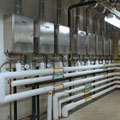
Bypassing roadblocks
Colorado firm helps green schools overcome restrictive state water laws.
Paul Hutton, LEED AP, is all for green plumbing technologies in schools. But Hutton and other architects and engineers must work around Colorado laws in order to help schools reduce water and energy usage.
“We have some unique and challenging water issues,” says Hutton, principal of Hutton Architecture Studio in Denver. “Rainwater harvesting is becoming fairly standard for green schools around the country. Here in Colorado it’s difficult for two main reasons.”
The first reason is Colorado’s semi-arid weather conditions. “It’s not quite a desert here, but there is not much of a resource to harvest even if you were able to set up a route to direct water to a cistern,” he says. “It’s hard when you don’t have a reliable rain water source.”
The much more restrictive problem deals with Colorado water laws. “Rainwater harvesting is basically illegal in Colorado,” Hutton explains. “Every drop of rain or flake of snow is already adjudicated to an ‘owner.’ A rain barrel at your downspout is technically illegal. You don’t have the legal right to use rainwater here to flush toilets. None of us owns the precipitation that strikes our land. The water still belongs to someone else. Farmers who rely on the Platte River to irrigate crops may be some of those downstream owners. If I were to retain water on my property, those farmers would have the right to sue me for release of that water.”
Hutton has found a way to work with the rainwater harvesting restrictions. “With a couple of charter schools, we’ve done detention on our roofs to slow down the release of rain water to minimize costs for on-site detention features,” he says. “You have 24 hours to release it. All we’re doing is slowing it down. We’re not using it for any other purpose.”
The implementation of a graywater system in Colorado also brings with it plenty of challenges. “You would think graywater usage would be more straightforward if you don’t have the rain as a resource,” Hutton says. “This has nothing to do with water rights. It’s coming from the state health department. There is an overriding concern for potential health implications from cross-contamination. It is very difficult to get a graywater permit. Capturing water out of the sink to flush toilets is not an easy thing here. People continue to work on getting the legislature to change that. I think there is much more of a chance to change graywater use here than rainwater harvesting.”
Instead, Hutton sees technologies such as evaporative cooling, radiant heating, horizontal and vertical geo-exchange systems and some solar thermal systems that are helping schools throughout the state become more sustainable.
Geothermal systems are another complicated issue due to state water laws. “You drill down 3,000 ft. and extract hot water from a geologic hot spot and you have to drill another well 3,000 ft. and re-inject it,” he says. “At that kind of pressure and to keep water chemistry intact, the costs become prohibitive. We haven’t seen a way to use true geothermal (as opposed to more basic geo-exchange) cost-effectively. We thought we were sitting on a goldmine of free energy at one of our school projects. Imagine how much energy it takes to inject water 3,000 feet back into the ground? You are using a lot more energy than energy saved. Water is definitely our biggest challenge here.”
One newer technology Hutton is excited about is the use of ice storage for energy efficiency. Hutton’s team designed one particular ice system at the Cherry Creek School District’s Institute of Science and Technology.
“The system makes ice at night because the temperature is so much cooler here and electricity is cheaper then,” he says. “It makes ice in three very large tanks and that ice melts during the day and provides a majority of the cooling. It makes the chiller far smaller by doing that. We’ve seen this type of technology in Colorado for at least 10 years. We have done six in schools. Schools are good candidates for it. When you have the utility company with a high demand charge and night temperatures that are significantly cooler than during the day, those circumstances make it work well.”
Despite dealing with restrictions from the state, Hutton embraces the opportunity to find new ways to help schools reduce operating costs.
“We are always looking for a challenge,” he says. “We’ll take the resources we have and use them more creatively. We enjoy that.”

Bypassing roadblocks
Colorado firm helps green schools overcome restrictive state water laws.
Paul Hutton, LEED AP, is all for green plumbing technologies in schools. But Hutton and other architects and engineers must work around Colorado laws in order to help schools reduce water and energy usage.
“We have some unique and challenging water issues,” says Hutton, principal of Hutton Architecture Studio in Denver. “Rainwater harvesting is becoming fairly standard for green schools around the country. Here in Colorado it’s difficult for two main reasons.”
The first reason is Colorado’s semi-arid weather conditions. “It’s not quite a desert here, but there is not much of a resource to harvest even if you were able to set up a route to direct water to a cistern,” he says. “It’s hard when you don’t have a reliable rain water source.”
The much more restrictive problem deals with Colorado water laws. “Rainwater harvesting is basically illegal in Colorado,” Hutton explains. “Every drop of rain or flake of snow is already adjudicated to an ‘owner.’ A rain barrel at your downspout is technically illegal. You don’t have the legal right to use rainwater here to flush toilets. None of us owns the precipitation that strikes our land. The water still belongs to someone else. Farmers who rely on the Platte River to irrigate crops may be some of those downstream owners. If I were to retain water on my property, those farmers would have the right to sue me for release of that water.”
Hutton has found a way to work with the rainwater harvesting restrictions. “With a couple of charter schools, we’ve done detention on our roofs to slow down the release of rain water to minimize costs for on-site detention features,” he says. “You have 24 hours to release it. All we’re doing is slowing it down. We’re not using it for any other purpose.”
The implementation of a graywater system in Colorado also brings with it plenty of challenges. “You would think graywater usage would be more straightforward if you don’t have the rain as a resource,” Hutton says. “This has nothing to do with water rights. It’s more coming from the state health department. There is an overriding concern for potential health implications from cross-contamination. It is very difficult to get a graywater permit. Capturing water out of the sink to flush toilets is not an easy thing here. People continue to work on getting the legislature to change that. I think there is much more of a chance to change graywater use here than rainwater harvesting.”
Instead, Hutton sees technologies such as evaporative cooling, radiant heating, horizontal and vertical geo-exchange systems and some solar thermal systems that are helping schools throughout the state become more sustainable.
Geothermal systems are another complicated issue due to state water laws. “You drill down 3,000 ft. and extract hot water from a geologic hot spot and you have to drill another well 3,000 ft. and re-inject it,” he says. “At that kind of pressure and to keep water chemistry intact, the costs become prohibitive. We haven’t seen a way to use true geothermal (as opposed to more basic geo-exchange) cost-effectively. We thought we were sitting on a goldmine of free energy at one of our school projects. Imagine how much energy it takes to inject water 3,000 feet back into the ground? You are using a lot more energy than energy saved. Water is definitely our biggest challenge here.”

